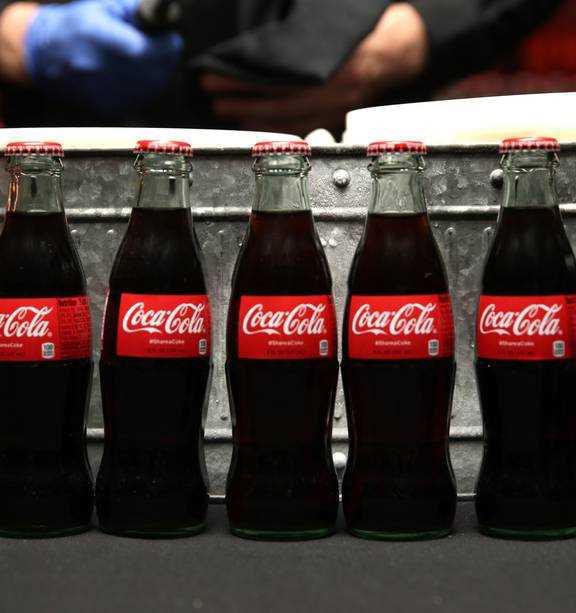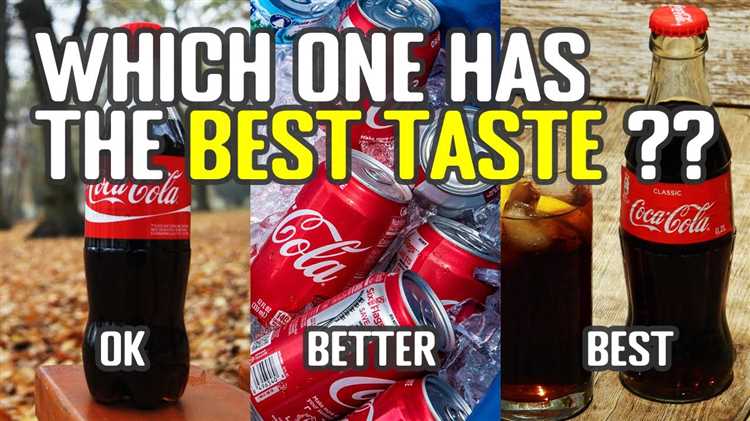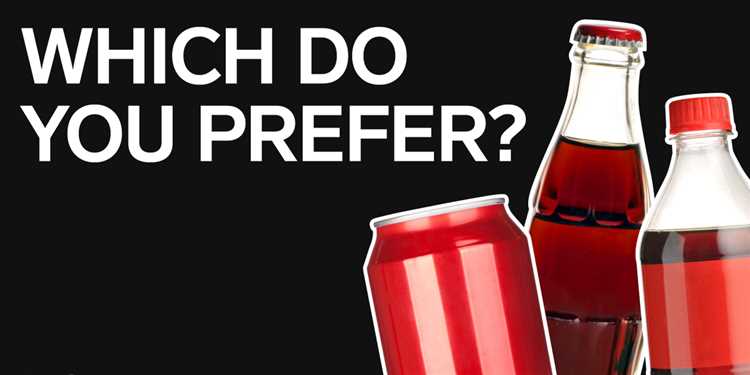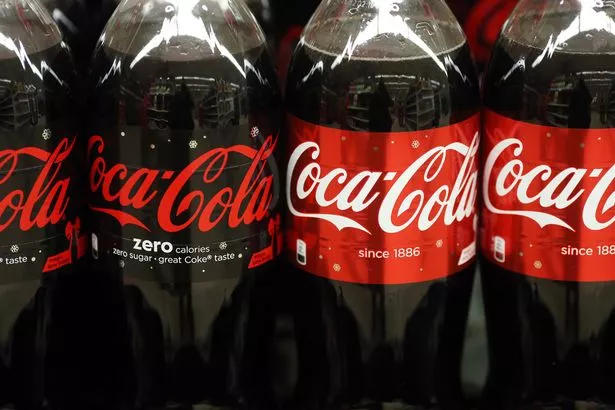
There’s something about that classic glass bottle that just makes the Coca-Cola experience so much better. Whether it’s the distinctive shape, the satisfying sound of the cap being opened, or the way the condensation forms on the cold glass, drinking Coca-Cola from a glass bottle is a sensory experience like no other.
But it’s not just the aesthetics that make Coca-Cola taste better in a glass bottle. There are actually scientific reasons why the iconic soda is more enjoyable from glass. For starters, glass is an impermeable material, which means that no air or other substances can get in or out of the bottle. This helps to preserve the carbonation and flavors of the soda, resulting in a fresher and crisper taste.
Furthermore, glass is a neutral material that doesn’t react with the acids and sugars in Coca-Cola. This means that when you drink Coke from a glass bottle, you’re getting the purest, most authentic flavor of the soda. On the other hand, plastic and metal containers can sometimes impart a slight taste to the beverage, affecting its overall enjoyment.
- The Influence of Glass Bottles on the Flavor of Coca-Cola
- Presentation and Sensory Experience
- Preservation of Carbonation
- The Unique Properties of Glass Bottles
- Durability and Safety
- Airtight Seal
- How the Shape and Design of Glass Bottles Enhance the Coke Experience
- Aesthetic Appeal
- Sensory Perception
- The Chemical Reactions between Coca-Cola and Glass Bottles
- The Role of Glass Composition
- The Importance of Glass for Packaging
- The Role of Glass Bottles in Keeping Coca-Cola Fresh
- 1. The Gas Barrier
- 2. Light Protection
- The Nostalgic Appeal of Coca-Cola in Glass Bottles
- A Taste of History
- A Sustainable Choice
- Question and answer:
- Why do some people think Coke tastes better in glass bottles?
- What is the reason behind the perception that Coke in glass bottles has a better taste?
- Is there a scientific reason why Coke tastes better in glass bottles?
- Does Coca-Cola actually taste different when consumed from different containers?
- What are the advantages of drinking Coke from a glass bottle?
- Why does Coke taste better in glass bottles?
The Influence of Glass Bottles on the Flavor of Coca-Cola
When it comes to the iconic taste of Coca-Cola, the type of packaging it comes in can have a significant impact on the overall flavor experience. One packaging option that has long been associated with Coca-Cola is the glass bottle. But what is it about glass bottles that make Coke taste better?
Presentation and Sensory Experience
One of the main reasons for the superior flavor experience in glass bottles is the way they present the beverage. The clear glass allows consumers to see the rich caramel color and the iconic bubbles dancing within. This visual presentation enhances the overall sensory experience of drinking Coca-Cola.
In addition to the visual aspect, the tactile experience of drinking from a glass bottle can also contribute to a heightened flavor perception. The weight and smoothness of the glass provide a more luxurious and satisfying feel, making each sip more enjoyable.
Preservation of Carbonation

Glass bottles are known for their ability to seal in carbonation effectively. This means that when Coca-Cola is stored in a glass bottle, the carbonation levels are better preserved compared to other packaging options like plastic bottles or cans.
When opened, the pressure within the glass bottle releases a satisfying “pop” sound, indicating that the carbonation is well-preserved. The retention of carbonation ensures that each sip of Coca-Cola from a glass bottle has the perfect level of fizz, enhancing the overall flavor profile of the drink.
| Advantages of Glass Bottles | Disadvantages of Glass Bottles |
|---|---|
| Preserves carbonation better | Can be more expensive to produce |
| Enhances visual presentation | Can break if mishandled |
| Provides a luxurious tactile experience | Heavier to carry and transport |
While glass bottles have undeniable advantages when it comes to preserving the flavor of Coca-Cola, they do come with some drawbacks. The production cost of glass bottles is higher compared to other packaging options, which can be reflected in the retail price to the consumer. Glass bottles can also break if mishandled, and their weight makes carrying and transporting them slightly more challenging compared to cans or plastic bottles.
However, for many Coca-Cola enthusiasts, the superior flavor experience provided by drinking from a glass bottle outweighs these disadvantages. So, the next time you open a Coca-Cola, consider reaching for a glass bottle and enjoy the enhanced taste and satisfaction it brings.
The Unique Properties of Glass Bottles
Glass bottles have long been favored for storing beverages, and for good reason. The unique properties of glass make it an ideal material for preserving the taste and quality of drinks like Coca-Cola.
Durability and Safety
Glass bottles are known for their durability, which is essential for protecting the contents inside. Unlike plastic, glass bottles can withstand extreme temperatures without risk of melting or emitting harmful chemicals. This ensures that the flavor and integrity of the Coca-Cola is preserved, even in challenging conditions.
Furthermore, glass bottles are non-reactive, meaning they do not interact with the contents of the bottle. This eliminates the risk of any unwanted flavors or chemicals leaching into the drink, ensuring a pure and untainted taste.
Airtight Seal
Glass bottles provide an airtight seal, keeping the carbonation in and the oxygen out. This is crucial for maintaining the fizzy sensation and freshness of Coca-Cola. The tight seal prevents the escape of carbon dioxide, which is responsible for the signature fizziness of the drink.
In addition, the airtight seal helps to preserve the flavor of Coca-Cola by preventing the absorption of external odors and flavors. This means that the drink will taste the same as when it was first bottled, even months or years later.
The unique properties of glass bottles, including their durability, non-reactivity, and airtight seal, contribute to the superior taste of Coca-Cola when compared to other packaging options. By choosing glass bottles, Coca-Cola ensures that consumers can enjoy the refreshing and iconic taste they have come to love.
How the Shape and Design of Glass Bottles Enhance the Coke Experience
When it comes to enjoying a refreshing Coca-Cola, the choice of packaging plays a significant role. While many people may argue that the taste remains the same regardless of the container, there is a unique experience that comes with drinking Coke from a glass bottle. The shape and design of glass bottles not only enhance the overall aesthetic appeal but also have a profound impact on the sensory perception of the drink.
Aesthetic Appeal
Glass bottles have a timeless appeal that adds a touch of sophistication to the Coke drinking experience. The sleek and elegant design of glass bottles makes them stand out from the crowd. Their transparency allows the vibrant color of the drink to shine through, making it even more visually appealing. Holding a glass bottle in your hands and seeing the iconic Coca-Cola logo imprinted on it adds to the anticipation and excitement of enjoying the beverage.
Sensory Perception
The shape of the glass bottle also affects the sensory perception of Coke. The narrow neck of the bottle concentrates the aroma, intensifying the smell of the drink as you take a sip. This amplification of the scent enhances the overall flavor experience. Additionally, the weight and feel of the glass bottle in your hands provide a satisfying tactile experience, making each sip more enjoyable.
The design of glass bottles also helps to maintain the carbonation levels of the drink. The tight seal of the bottle cap prevents carbonation from escaping, preserving the fizz and ensuring that every sip is as refreshing as the first. This is especially important for Coke enthusiasts who appreciate the distinct tingle and effervescence that comes with each sip.
In conclusion, the shape and design of glass bottles enhance the overall Coke experience. From their aesthetic appeal and the anticipation they create to the sensory perception they enhance, glass bottles provide a unique and enjoyable way to savor this iconic beverage. So, the next time you have a choice, consider opting for a glass bottle and elevate your Coke-drinking experience to a new level.
The Chemical Reactions between Coca-Cola and Glass Bottles
When Coca-Cola comes into contact with glass bottles, a series of chemical reactions occur that can affect the taste of the drink.
Firstly, the glass itself is composed of silicon dioxide, which can react with the phosphoric acid found in Coca-Cola. This reaction can lead to the formation of sodium phosphate and calcium phosphate compounds, which can alter the pH of the drink. The change in pH can affect the perception of taste, leading to a more enjoyable drinking experience.
In addition to the reaction with phosphoric acid, glass bottles can also react with the carbon dioxide gas present in Coca-Cola. Carbon dioxide can dissolve in the liquid and form carbonic acid when it comes into contact with water. This carbonic acid can then react with the silicon dioxide in the glass, leading to the formation of bicarbonates. Bicarbonates can contribute to the overall flavor profile of the drink, giving it a distinct taste when compared to other packaging materials.
The Role of Glass Composition
The composition of the glass used to make the bottles can also influence the chemical interactions between Coca-Cola and the packaging material. For example, glass bottles with a higher concentration of alkali metal oxides, such as sodium oxide or potassium oxide, can react more readily with the phosphoric acid and carbon dioxide in the drink. This can lead to a stronger chemical reaction and potentially enhance the taste of Coca-Cola.
On the other hand, glass bottles with a higher concentration of alumina or boron, such as borosilicate glass, may have a lower reactivity with Coca-Cola. This can result in a milder chemical reaction and potentially a different taste experience.
The Importance of Glass for Packaging
Given the chemical interactions between Coca-Cola and glass bottles, it is clear that the choice of packaging material can significantly impact the taste of the drink. Glass bottles provide a unique combination of reactivity and stability that can enhance the overall flavor and enjoyment of Coca-Cola. This is why many people believe that Coke tastes better when consumed from a glass bottle.
So next time you enjoy a refreshing glass of Coca-Cola, take a moment to appreciate the intricate chemical reactions happening between the drink and the glass bottle, and savor the unique taste experience that only a glass bottle can provide.
The Role of Glass Bottles in Keeping Coca-Cola Fresh
Glass bottles have played a significant role in maintaining the freshness and quality of Coca-Cola for decades. This classic packaging material offers several advantages that help preserve the iconic taste and fizziness of the beverage.
1. The Gas Barrier

One of the main reasons why glass bottles are preferred for Coca-Cola is their ability to provide an excellent gas barrier. Glass is impermeable to both oxygen and carbon dioxide, which are the two primary enemies of freshness in carbonated drinks.
Oxygen can alter the taste and color of Coca-Cola, causing it to become flat and develop off-flavors. Carbon dioxide, on the other hand, is responsible for the effervescence and characteristic fizziness of the drink. Glass bottles ensure that these gases stay inside the bottle, preserving the original flavor and mouthfeel of Coca-Cola.
2. Light Protection
Glass bottles offer superior light protection compared to other packaging materials. Sunlight and certain artificial light sources contain ultraviolet (UV) rays that can degrade the flavor and freshness of Coca-Cola.
The amber or dark brown color of glass bottles helps to block out UV rays and prevent light-induced reactions that can affect the taste and quality of the beverage. This is especially crucial for drinks like Coca-Cola that are sensitive to light exposure.
Moreover, glass does not emit any chemicals or substances that could react with the drink, ensuring that the taste and quality of Coca-Cola remain untouched.
Overall, glass bottles not only preserve the iconic flavor of Coca-Cola but also enhance the drinking experience by maintaining the characteristic fizziness and freshness.
The Nostalgic Appeal of Coca-Cola in Glass Bottles
There is something undeniably charming and nostalgic about sipping a Coca-Cola from a glass bottle. The experience takes us back to a simpler time, evoking memories of hot summer days, childhood innocence, and carefree moments.
These iconic glass bottles have been around since the introduction of Coca-Cola over a century ago. Classic and timeless, they have become a symbol of the brand, representing quality and tradition.
A Taste of History

Drinking Coca-Cola from a glass bottle allows us to feel a connection to the past. It reminds us of a time when things were simpler and technology had not yet dominated our lives. It brings to mind images of old-fashioned soda fountains, corner stores, and the satisfaction of enjoying a cold Coke on a hot day.
Not only does the glass bottle add to the nostalgic charm, but it also enhances the taste of Coca-Cola. The smoothness and effervescence of the drink are enhanced when sipped from glass, as opposed to being consumed from a plastic or aluminum container.
A Sustainable Choice
In addition to the sentimental value, glass bottles also offer an environmentally friendly alternative to plastic bottles. They are endlessly recyclable, making them a sustainable choice for conscious consumers. By choosing Coca-Cola in glass bottles, we can help reduce plastic waste and contribute to a cleaner, greener future.
Ultimately, the nostalgic appeal of Coca-Cola in glass bottles goes beyond mere packaging. It is a connection to our past and a reminder of simpler times. So next time you crack open a cold, fizzy Coca-Cola from a glass bottle, take a moment to savor not just the taste, but the memories it brings with it.
Question and answer:
Why do some people think Coke tastes better in glass bottles?
Some people believe that Coke tastes better in glass bottles because they feel that the glass preserves the carbonation and keeps the soda colder for longer.
What is the reason behind the perception that Coke in glass bottles has a better taste?
The perception that Coke in glass bottles has a better taste may be due to a combination of factors. Glass is believed to preserve the carbonation and keep the drink colder for longer. Additionally, the texture of the glass may contribute to a more enjoyable drinking experience.
Is there a scientific reason why Coke tastes better in glass bottles?
There is no scientific evidence to support the claim that Coke tastes better in glass bottles. However, some people believe that glass preserves the carbonation and keeps the drink colder, which may enhance the taste for them.
Does Coca-Cola actually taste different when consumed from different containers?
Coca-Cola does not taste different when consumed from different containers. The taste of Coca-Cola is primarily determined by its ingredients, recipe, and manufacturing processes, rather than the container it is served in.
What are the advantages of drinking Coke from a glass bottle?
Drinking Coke from a glass bottle can have some advantages. Glass is believed to preserve carbonation for longer, which can result in a fizzier drink. Additionally, the glass container can help keep the Coke colder for a longer period of time. Some people also enjoy the texture and feel of the glass when drinking from it.
Why does Coke taste better in glass bottles?
Coke tastes better in glass bottles because glass does not react with the soda and alter its taste, unlike other materials such as cans or plastic bottles. This helps to preserve the original flavor of the Coke and makes it taste crisper and fresher.